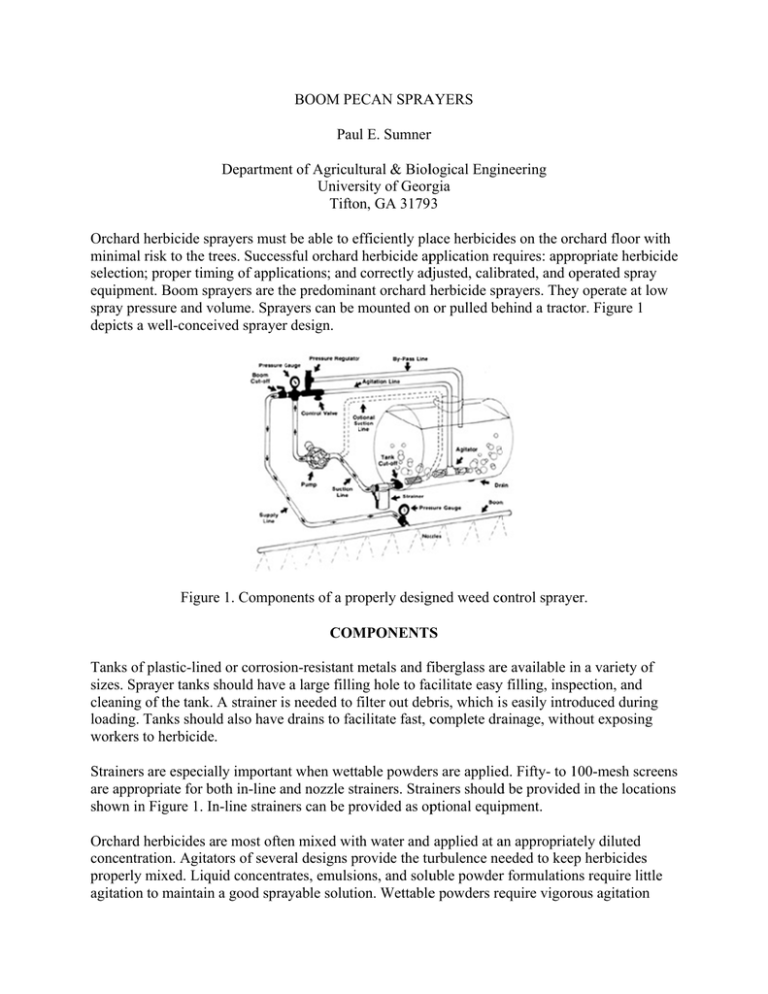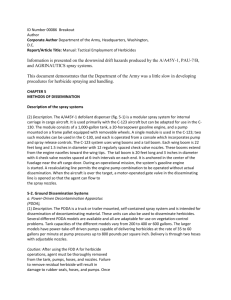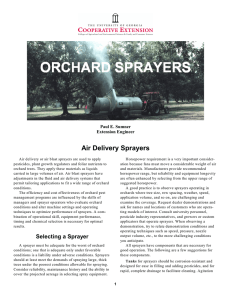BOOM PE ECAN SPRA AYERS Pau
advertisement

BOOM PE ECAN SPRA AYERS Pau ul E. Sumnerr Departmen nt of Agricultural & Biollogical Enginneering Univerrsity of Georrgia Tifto on, GA 3179 3 Orchard herbicide sp prayers must be able to efficiently plaace herbiciddes on the orcchard floor w with minimal risk to the trrees. Successsful orchard herbicide appplication reequires: apprropriate herbbicide selection n; proper timing of appliccations; and correctly addjusted, calibbrated, and ooperated spraay equipmen nt. Boom sprayers are th he predominaant orchard hherbicide spprayers. Theyy operate at low spray preessure and vo olume. Spray yers can be mounted m on or pulled beehind a tractoor. Figure 1 depicts a well-conceiived sprayerr design. Figuree 1. Compon nents of a pro operly desiggned weed coontrol sprayeer. COM MPONENTS S Tanks off plastic-lined d or corrosio on-resistant metals m and ffiberglass aree available inn a variety oof sizes. Sprrayer tanks should s have a large fillin ng hole to faacilitate easyy filling, insppection, and cleaning of the tank. A strainer iss needed to filter f out debbris, which is easily introoduced durinng loading. Tanks shoulld also have drains to faccilitate fast, ccomplete draainage, withhout exposingg workers to t herbicide. Strainers are especiallly importan nt when wettaable powderrs are appliedd. Fifty- to 1100-mesh screens are appro opriate for bo oth in-line an nd nozzle strrainers. Straainers shouldd be providedd in the locaations shown in n Figure 1. In n-line straineers can be prrovided as opptional equippment. Orchard herbicides are a most ofteen mixed witth water and applied at aan appropriattely diluted concentraation. Agitattors of severral designs prrovide the tuurbulence neeeded to keepp herbicidess properly mixed. Liqu uid concentraates, emulsio ons, and soluuble powderr formulationns require litttle agitation to maintain a good spraayable solutio on. Wettablee powders reequire vigoroous agitationn because they readily settle out. The bypass hose agitation alone normally does not furnish enough agitation for wettable powders. Jet agitators, sometimes referred to as hydraulic boosters, should be used to maintain proper agitation. Pumps of four designs (roller, centrifugal, piston, and diaphragm) are common on herbicide sprayers. Three factors should be considered in selecting pumps for herbicide sprayers: capacity, pressure, and resistance to corrosion and wear. Each pump design offers advantages and disadvantages. Pump capacity should be sufficient to readily supply the boom output, provide agitation, and offset pump wear. If hydraulic, or jet, agitation is used, allow at least 5-7 GPM for each 100 gallons of tank capacity to provide mixing action. Suitable agitation can also be obtained by pumping 2 GPM per 100 gallons of tank capacity through a siphon, or venturi, agitator that increases the flow through the agitator by 2.5 times. Of course, mechanical agitation does not require any pump capacity. Finally, add 20 to 25 percent to spraying and agitation requirements to compensate for loss of power from pump wear. The pressure control system of a sprayer consists of a pressure regulator, pressure gauge, and cutoff valve. These components should be within easy reach of the driver. The pressure regulator controls the pressure to nozzles and relieves excess pressure, which allows some of the liquid to return to the tank through the bypass hose. For low-pressure sprayers, a pressure gauge with a 0 to 100 PSI range is desirable. A quick-acting cutoff valve handy to the driver is also necessary on a sprayer. Often, valves are provided so that the side and center sections of the boom can be cut off independently. Boom sprayers get their name from the booms or long spray-bearing arms that extend laterally to cover a particular swath as the sprayer passes over the field. Booms may be “wet” or “dry.” Wet booms use the material of the boom as the conduit for the spray liquid. Pipes or rigid tubes through which the material passes are utilized. Dry booms have a rigid boom constructed of angle iron, channel iron, or pipes to which hoses and fittings carrying the spray liquid are attached. The spray material passes through the hoses and not the boom itself. Dry boom sprayers are more common. Flexible nozzle spacing, ease of repairs, and cost favor dry booms. Nozzles meter flow, atomize the liquid in a targeted range of droplet sizes, and disperse the droplets in a specific pattern for proper impact with plants or soil. Nozzles are available in brass, polymer, stainless steel, hardened stainless steel, and ceramic. Brass and polymer nozzles are most popular, primarily due to low cost. Stainless steel and hardened stainless steel nozzles last three to 15 times longer than brass. Ceramic nozzles last about 100 times longer than brass. Herbicide nozzles should provide uniform distribution of spray solution and develop a large droplet to minimize drift. Nozzles commonly used for broadcast herbicide applications include the regular flat fan, extended-range flat fan, drift-reduction flat fan, turbo flat fan, twin flat fan, and air-induction flat fan. Operating pressure varies with nozzle type. Tips such as the extended-range flat fan and turbo flat fan nozzles are designed for operating pressures from 15 to 30 PSI, which reduce drift by producin ng large drop plets that are dispersed un nder low sprray pressure. Drift-reducction flat fann and air-inducction flat fan nozzles are operated at pressures off 30 PSI or m more. These tips are desiigned to producce larger sprray droplets to t minimize drift at theirr specified ooperating preessures. Operating nozzle tipss at other thaan the speciffied pressurees may resultt in a poor pattern and leess than desiirable pattern n overlap. Figure 2A A. Flat fan nozzles n should bee angled at approxim mately 5% from parallel to the boom. All nozzles should s be turrned the same direection. Grap phics by Will Ham mpton. Figure 2B B. Angling nozzles n assures a similar deposition of spray maaterial all alo ong the spray ban nd, without the t particles shearing and d drift potential seen when the t edges of spray patterns p colllide in the air. Graphics by Willl Hampton n. Spray angle of nozzlees also impaacts drift potential. Tips tthat producee a broader ppattern (110 ° ) are preferred becausee they can bee operated clloser to the aapplication ttarget, whichh minimizes drift by shorteening the disstance spray solution trav vels. Flat fann nozzles shoould be unifformly spaceed to provide 50 5 to 60 perccent overlap. Table 1 sug ggests boom m heights for flat fan nozzzles with different angles. Spraay particles that t encountter one anothher while in flight to the ground are drift prone. To o avoid this disruption, the t orientatio on of each fllat fan alongg the boom shhould be anggled, or canted d, at an anglee of 5 degreees from the center c line off the boom ((Figure 2A) to produce tthe desired 50 5 to 60 perccent overlap in spray on the t ground w without interrsection of sppray from individuaal nozzles (F Figure 2B). Table 1. Suggested minimum spray nozzle height (flat fan). Spray Tip Nozzle Height (Inches) 1 Angle 20” Spacing 30” Spacing 65 22 - 24 33 - 35 80 17 - 19 26 - 28 110 10 - 12 14 - 18 1 Nozzle height should be adjusted so that spray pattern overlaps 50-60 percent. CALIBRATION OF BOOM SPRAYERS Calibration of sprayer equipment is very important. Inaccurate calibration can cost money and may cause crop damage. Sprayers should be calibrated often to guard against using excessive amounts of pesticides, which may occur as nozzle wear progresses. Safety and economics dictate calibrating with water alone. Care should be taken while working with sprayers and pesticides in the field. A plastic jug of clean water should always be carried on the tractor in case of pesticide contamination . In orchards, herbicide strip applications normally spray 100% of the orchard floor beneath the trees' drip line. To determine the sprayed acreage (herbicide strips), divide the herbicide strip width by the tree row width, then multiply by the total acres of trees. This calculation will yield the actual number of acres in the herbicide-treated strip beneath the trees. Calibration Procedure The procedure below is based on spraying 1/128 of an acre per nozzle or row spacing, and collecting the spray that would be released during the time it takes to spray the area. Because there are 128 ounces of liquid in 1 gallon, this convenient relationship results in ounces of liquid collected being directly equal to the application rate in gallons per acre. Use clean water when calibrating sprayers for applying pesticides that are to be mixed with water. Check uniformity of nozzle output across the boom. Collect from each nozzle for a known time period to ensure each is within 10 percent of the average output. Insert new nozzles if necessary. When applying materials that are appreciably different from water in weight or flow characteristics, such as fertilizer solutions, for example, calibrate with the material to be applied. Exercise extreme care and use protective equipment whenever calibrating sprayers with an active ingredient. Table 2. Calibration distances with corresponding widths ( To determine the distance for spacing or band width not listed, divide the spacing or band width expressed in feet into 340.3. Example: for a 13” band the calibration distance would be 340.3 divided by 13”/12” = 314.1.) Nozzle Spacing (Inches 48 36 30 24 20 18 16 14 12 10 Calibration Distance (Feet) 85 113 136 170 204 227 255 292 340 408 Step 1. From Table 2, determine the distance to drive in the field (two or more runs suggested). For broadcast spraying (typically 100% of the area beneath the trees' drip line) measure the distance between nozzles. Step 2. With all equipment attached and operating, measure the time (seconds) to drive the required distance. Make note of throttle setting and gear. Step 3. With the sprayer sitting still and operating at same throttle setting or engine RPM as used in Step 2, adjust pressure to the desired setting. Machine must be operated at same pressure used for calibration. Step 4. Collect spray from one nozzle for the number of seconds required to travel the calibration distance. Step 5. Measure the amount of liquid collected in fluid ounces. The number of ounces collected is the gallons per acre rate on the coverage basis indicated. For example, if you collect 18 ounces, the sprayer will apply 18 gallons per acre. Adjust applicator speed, pressure, and nozzle size to obtain desired spray volume. If speed is adjusted, start at Step 2 and recalibrate. If pressure or nozzles are changed, start at Step 3 and recalibrate. Step 6. Verify that all nozzles along the spray boom are delivering the same volume (+/- 5–10%). Step 7. To determine the amount of pesticide to put into a sprayer tank, divide the total number of gallons of mixture to be made (tank capacity for a full tank) by the spray output in gallons per acre (Step 5) and use the recommended amount of pesticide for this number of acres. Step 8. Sprayers should be checked frequently for proper calibration. Sprayer calibration sheets and wallet-size cards are available from your local county extension office or on the web at http://www.ugaspray.org .




